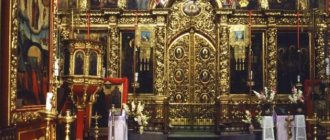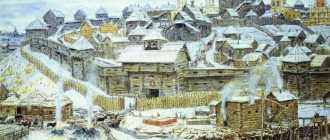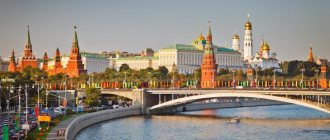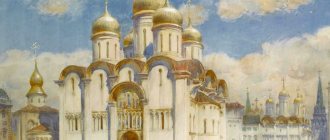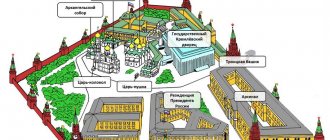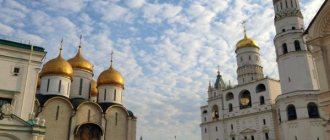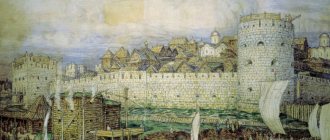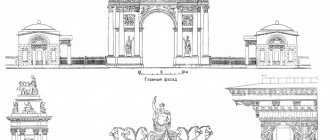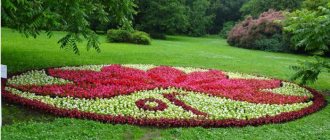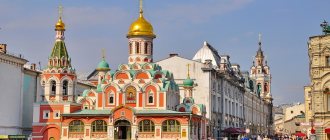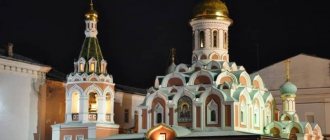The focus of this article will be the Archangel Cathedral of the Moscow Kremlin. The monumental sacred structure attracts attention with its atypicality, even foreignness. Its domes, except for the main one, do not have gilding. And from the outside the cathedral looks like an Italian palazzo from the High Renaissance. But the outer aisles and gallery correlate the church with the ancient Russian canons of architecture. What's inside? The interiors seem to be imbued with the idea of autocracy, glorified by the Russian Orthodox Church. And this is not surprising: after all, the temple was originally conceived as a palace chapel, and also the tomb of all Moscow princes of the “male sex”.
Grand duchesses and queens were buried in the nearby Ascension Cathedral. After it was blown up, the remains of the women were transferred to Arkhangelsk. Is it possible to see it all? Without a doubt. After all, since 1955 there has been a museum in the Archangel Cathedral. And on major religious holidays, services are held in the temple. An interesting detail: before each of them, the cathedral is consecrated anew. Let's go together on a virtual tour of this temple. The photographs presented below will help you get an idea of the elaborate architecture and beautiful rich decoration of this miracle of Italo-Russian architecture.
Archangel Cathedral of the Moscow Kremlin: history
Why is it named like that? Archangel Michael has long been considered the patron saint of Moscow princes in their military affairs. The leader of the angels, who defeated Satan with the heavenly army, was honored by them. Going on a campaign, the Russian princes turned to him with a prayer for victory. That is why the Archangel Cathedral simply had to appear on Cathedral Square of the Moscow Kremlin. And he appeared, although not as we see him today. The first building, like the entire Kremlin, was made of wood. Most likely, it was erected during the short reign of Prince Mikhail Khorobrit (1247-1248), brother of Alexander Nevsky. It was the second largest church in the city. However, the first Archangel Cathedral of the Moscow Kremlin was not intended for the burials of princes. Mikhail Khorobrit himself, who died in the war with the Lithuanians, rests in the Assumption Church in Vladimir. And only starting with the nephew of this prince, Daniel, who inherited the throne, are Moscow rulers buried within the Archangel Cathedral. But soon the wooden temple will be demolished and a stone one will be built in its place. Therefore, there was no real tomb in the first church. Daniel was buried near the southern wall, and his son Yuri was buried in the temple itself.
Archangel Cathedral of the Moscow Kremlin
The Archangel Cathedral adorns the southern – “princely” part of Cathedral Square. It is located next to the Annunciation Cathedral and is one of the main churches on the territory of the Moscow Kremlin. Until the 18th century. great princes and tsars found eternal rest there, and now we perceive this architectural monument as a piece of the “living and visible” history of the Russian state.
During the Middle Ages, both Rus' and European countries were in constant struggle, be it external enemies or internecine conflicts. Moreover, the main problem was not robbers and civil wars, but the struggle between appanage princes. Civil strife occurred over land, money or the Grand Duke's throne. There were few wise politicians then who advocated unification, like Alexander Nevsky.
One way or another, wars in Rus' did not stop, and all men were potential warrior-defenders. Archangel Michael has long been considered the heavenly patron of the entire army in Rus'. In honor of this saint, a wooden temple was erected under Alexander Nevsky’s brother Mikhail Khorobrit on the territory of the Moscow Kremlin. During the reign of Grand Duke Ivan Kalita, it was recreated in stone.
Ivan III again took up the reconstruction of the Archangel Cathedral and invited the Italian architect Aleviz Novy or Fryazin for this purpose. The masters were given such an unusual nickname already in Russia, because they simply could not pronounce the real name of Alois Lamberti and Montagnana. Alois-Aleviz took the matter seriously and began studying Russian culture. At the same time, he fell in love with everything Russian so much that he even began to dress differently, replacing exquisite Italian outfits with high-quality Russian suits.
The temple was planned to be used as a tomb for the grand ducal family. Aleviz the New, like his predecessor, the builder of the Kremlin Assumption Cathedral, Aristotle Fiorovanti, had to carefully study traditional Russian temple construction and follow its basic principles. However, he completed the task creatively and recreated the external appearance of the cathedral, adding Italian design features. From the facades, the temple was divided into two horizontal parts using a cornice, and instead of blades traditional for Russian architecture, pilasters were installed in two rows, topped with Corinthian capitals. The zakomars are also separated by cornices, and carved shells are placed in the interior space as decoration.
During the construction of the new cathedral, Ivan III died and was buried within the still unfinished walls. Prince Vasily III had to become the trustee of the construction. From that moment on, the Archangel Cathedral became a tomb, where the Grand Dukes found rest, and then the tsars up to Peter the Great.
In the 16th century, the temple was surrounded by galleries. It was originally decorated with paintings, but only the work of the masters has survived, which was completed in the period from 1652 to 1666 and accurately reproduced the previous one. The old painting can only be seen on the walls of the deacon, at the burial place of Ivan the Terrible.
The Archangel Cathedral sparkles with five domes. It belongs to the cross-dome type. The domes have a noticeable shift to the east, which is unusual for Russian architectural monuments. The shape of the pillars, or columns, is cross-shaped, and not round, like that of the Assumption Cathedral, built by Aristotle Fiorovanti. A two-tier porch was installed in the western part of the temple for members of the princely family, with a chapel in honor of Saint Aquilla.
In the second half of the 16th century, two single-domed chapels were added to the northern and southern apses - in memory of the martyr Huar and John the Baptist. They have separate entrances from the square.
The Archangel Cathedral is famous as the tomb of the royal families of Rurikovich and Romanov. In total, it contains 46 burials belonging to the royal dynasties. The first was Ivan Kalita, and the last was the brother of Peter I, Ivan Alekseevich. Boris Godunov was also buried here at first, but then the body of the founder of the failed dynasty was thrown out of the walls of the cathedral and transferred to the Trinity-Sergius Lavra by False Dmitry. Also buried in the cathedral are individuals elevated to the rank of saints - Tsarevich Dmitry Ivanovich and Mikhail Chernigovsky.
The Archangel Cathedral stands out for its iconostasis, which is of considerable historical value. It was installed in 1681, and the icons in most modern times date back to the same time. The main shrine is the oldest hagiographic icon of the Archangel Michael, which, according to legend, was created thanks to the wife of Prince Dmitry Donskoy, Evdokia.
The cathedral repeatedly experienced difficult times. During the Patriotic War of 1812, Napoleon placed a camp kitchen and a food warehouse in the altar building. During the rebellious revolutionary years, the cathedral was severely damaged by shelling and closed, and in 1929 the Ascension Monastery in the Kremlin was demolished and the remains of the female half of the grand ducal family were transferred to the temple. In the 50s of the last century, the cathedral became a museum, and in 1991 Patriarch Alexy II held a service there over the relics of Dmitry Donskoy, canonized by the Orthodox Church in 1988.
Now the temple consists of three altars: the central one in memory of the Archangel Michael, the southern aisle - the Conception of John the Baptist, the northern aisle - the martyr Huar, and at the western entrance - the aisle of the Intercession of the Most Holy Theotokos.
It is noteworthy that people made more efforts to destroy the temple than the inexorable time. It was shelled, closed and repaired again.
In the 70s of the 20th century it was restored and opened to the public. Now you can get to the Archangel Cathedral by purchasing tickets to the Kremlin territory.
The first stone cathedral
In the 30s of the fourteenth century, the Moscow Kremlin had already begun to take on its modern appearance. Stone cathedrals appeared: Assumption, Savior on Bor and St. John Climacus. Grand Duke of Vladimir and Moscow Ivan Danilovich Kalita completed the ensemble of the square. And the rye crop failure helped him in this. When the cereals began to grow everywhere and did not produce grain, the prince made a vow that he would build a stone cathedral to replace the dilapidated wooden one if his country avoided famine (and the associated rebellion). In fulfillment of his oath, in 1333 - in one summer, as the manuscripts say - he erected a church. It was already sprinkled by Metropolitan Theognostus in September. This Moscow Archangel Cathedral from the time of Kalita was small. The modest size is indicated by the short construction time and the entry in the Degree Book of the sixteenth century: in comparison with the “old” temple, “the new one was great.” Most likely, it was a one-domed four-pillar church, similar to the Savior on Bor. Later, chapels began to be built on it - most likely wooden. They bore names consonant with the names of Kalita’s sons, buried in the Archangel Cathedral - Andrei of Crete and Simeon the Stylite. A century and a half later, in 1471, the temple acquired two more chapels: the Resurrection and the Apostle Aquila. Is it possible to see anything left of the cathedral from Kalita's time? Scientists are still arguing about this. Some believe that the contemporary Archangel Cathedral of the Moscow Kremlin was built by a sixteenth-century architect “from scratch.” Others argue that the old building was not dismantled to its foundations, but was incorporated (fragmentarily) into the new one.
LiveInternetLiveInternet
Quote from Maya_Peshkova's message
Read in full In your quotation book or community!
His Majesty the Moscow Kremlin. Part 5. Cathedral of the Holy Archangel Michael (Arkhangelsk Cathedral)
The Cathedral of the Holy Archangel Michael (Archangel Cathedral) in the Kremlin was the tomb of the great princes and Russian tsars. In the old days it was called the “Church of St. Michael in the Square.”
From the moment of its foundation until the 18th century, the Archangel Cathedral served as the resting place of Moscow princes and tsars. Tombstones for princes with words of prayers and epitaphs on white stone slabs are located under the arches of the temple in strict order. Tombs of the Rurik dynasty are along the walls of the temple. The tombs of the kings from the Romanov dynasty are located at the southwestern and northwestern pillars. The first Russian Tsar Ivan the Terrible and his two sons were buried in a special royal tomb built in the altar part of the cathedral.
Panorama of the Kremlin in Moscow. Geithner Among the most revered shrines of the Archangel Cathedral were the relics of St. Prince Michael of Chernigov, who died a martyr in the Golden Horde, and St. Tsarevich Dmitry, the youngest son of Ivan the Terrible. The remains of the saints were not buried, but were placed in special arks - crayfish, intended for the worship of believers. The reliquary with the relics of Tsarevich Dmitry is installed at the southwestern pillar under a carved stone canopy.
The first stone Archangel Cathedral, in place of the wooden one, was founded in 1333 by Grand Duke Ivan Kalita in gratitude for deliverance from the great famine of 1332. This famine was called “grown rye” - the harvested bread sprouted in the heaps and all died in the fields due to incessant rains.
The people then lived quite “comfortably”, which was considered a true miracle and a large stone temple was founded in memory of this. That same year it was completed and consecrated by Metropolitan Theognostus.
The stone cathedral was built exactly on the site of the previously existing wooden Archangel Church. There are two versions among experts about the time of its appearance. According to the first, the wooden temple was built a very long time ago - at the end of the 11th - beginning of the 12th centuries, when young Moscow, like every city, was supposed to have its own temple in the name of the Chief of the Heavenly Forces, who had long been considered the patron of Russian warrior princes.
Archangel Michael in Scripture is called “prince,” “leader of the army of the Lord.” Others attribute the appearance of the wooden temple to the first half of the 13th century, during the reign of the first Moscow appanage prince known in the history of the city, Mikhail Khorobrit, brother of Alexander Nevsky. He founded a temple in Moscow in the name of his heavenly guardian, and this happened 20 years before the beginning of the reign of Prince Daniel of Moscow. Among the supporters of this “later” version, which is considered more reliable, was the famous pre-revolutionary historian of Moscow, Ivan Zabelin.
According to his calculations, the stone Archangel Church was the fifth one founded by Kalita in the Kremlin after the Assumption Cathedral, the Church of St. John the Climacus, the unpreserved Petroverigsky Church and the Church of the Savior on Bor. Then Kalita, who received the label for the great reign, built and equipped the Kremlin. It was during his time that the word itself appeared - the Kremlin.
John Climacus. Measured icon in setting. Workshops of the Moscow Kremlin. 1554 The icon belonged to the eldest son of Ivan the Terrible and Anastasia - Tsarevich Ivan Ivanovich (1554-1582). Moscow Kremlin Museums
In ancient times, on the site of its golden-domed cathedrals and battlements, a pine forest rustled, and therefore the hill on which the first wooden fortress walls of the city were erected was called Borovitsky. They appeared already in 1156 by order of Prince Yuri Dolgoruky.
The word “Kremlin” or “Kremnik”, as the Moscow fortress was called in chronicles, appeared for the first time in the 1339-40s - when Kalita ordered the construction of new city walls from durable oak
It is possible that the word “Kremlin” comes from the ancient Greek “kremnos” - “solid”, but it is more likely that it is based on the Slavic word “krem”, “kremnik”, meaning “pine forest” or “forest”. This name remained even after the new red brick Kremlin was built in the 15th century.
The new Archangel Cathedral, founded by Kalita, according to the thoughts of its founder and organizer, was supposed to become his last refuge. He was buried there first - in April 1340. Since then, all the rulers of Moscow and Russia until Peter I were buried here.
Cathedral of the Archangel. View of the ends of the tombstones Vel. book Ivan Danilovich Kalita (d.1340) Simeon Ivanovich Proud (1316-1353) and Prince. Georgy Vasilyevich (1533-1563) Tombstones in the first row near the southern wall. Photo by K. A. Fisher. 1905 From the collections of the Museum of Architecture. A.V. Shchusev Only two of them are buried outside this Kremlin tomb. The martyr of the capital city of Moscow, Prince Yuri Danilovich, brother of Ivan Kalita, killed in the Horde by Prince Dmitry of Tver in the struggle for the khan's label, was buried in the Assumption Cathedral. And his father, Prince Daniil of Moscow, found his last refuge within the walls of the Danilovsky Monastery.
Shortly before his death, Ivan III decided to rebuild the ancient Archangel Cathedral, or rather, to build a new one on the site of the dilapidated Kalita building: back in 1450, the Temple was damaged during a thunderstorm by a lightning strike and strong wind and has since been badly damaged.
On May 21, 1505, Grand Duke Ivan Vasilyevich ordered the old church to be dismantled and in October he founded a new one, but a few days later he died and was buried in the newly founded church. Vasily III Ivanovich And therefore, his son, Grand Duke Vasily III, was considered the organizer of the new Archangel Cathedral, under whom the temple was built and consecrated, which has survived to this day. For this, the ruler received special honor: his image in the temple painting was placed in the best place - on a pillar opposite the main entrance to the temple.
The Milanese architect Aleviz Fryazin was invited to work, from among the Italian masters who came at the invitation of the Moscow Grand Duke to build a brick Kremlin.
ALEVIZ FRYAZIN Novy (present Aloisio Lamberti da Montignana) - Italian architect of the late 15th - early 16th centuries, worked in Moscow from 1504. In 1499, the ambassadors of Ivan III Ralev and Karacharov, while staying in Italy, invited the architect Alois Lamberti da Montagnana to Russian service. The following year, together with the embassy, he headed to Moscow, where he arrived only in 1503. He spent three years at the court of the Crimean Khan Mengli-Girey, where in just 15 months he built a palace for him in Bakhchisarai (only the carved stone portal has survived). In Moscow he became known as Aleviz Fryazin
Aleviz built a cross-domed cathedral, traditional for ancient Russian Orthodoxy, but with elements of Italian architecture - for example, the decoration of zakomar - decorative shells with pearls. One old expert on Moscow even assessed the temple as a building of “bold Gothic architecture, mixed with ancient Greek.”
The relics of the “sovereign ancestors” were transferred to it, starting with Ivan Kalita. And on the patronal feast day, November 8, 1508, the new cathedral was consecrated in the name of Archangel Michael, the Chief of Heavenly Powers - so that the first guardian of human souls during his lifetime would also become the guardian of their bodies.
Cathedral of the Archangel. View of the ends of the tombstones of Tsar Vasily Ivanovich Shuisky (1557-1613), princes Staritsky: Vladimir Andreevich (after 1533-1569), Vasily Vladimirovich (c. 1552-c. 1574) and Andrei Ivanovich (1490-1536). Photo by K. A. Fisher. 1905 From the collections of the Museum of Architecture. A.V. Shchusev. Burial was performed in Rus' before sunset, so that the deceased could say goodbye to the sun before the Resurrection from the dead. The coffin was covered with a stone slab, and candles extinguished after the funeral service were placed on it - as a sign of extinguishing any hostility. In front of the tombs, lamps always glowed and candles burned: in their spiritual testaments, the princes ordered their children to observe “so that the memory of their parents does not cease and their candle on the coffins of their parents does not go out.”
Cathedral of the Archangel. General view of the tombstone of the imp. Peter II from the side, in the background part of the northwestern pillar. Photo by K. A. Fisher. 1905 From the collections of the Museum of Architecture. A.V. Shchusev. And above the coffin, covered with a stone slab, a stone tombstone was erected, on which an icon, a candle and a funeral dish with the eve were placed.
We see these tombstones now in the Archangel Cathedral - all burials are under the floor. In 1636-1637 the ancient tombstones were replaced with new brick ones with carved white stone walls, and in 1903 they were covered with bronze cases.
And in the Archangel Cathedral, from 1599 to 1765, there were “separate bishops” assigned to serve requiem services on the days of the death of the highest persons buried here - princes and kings. Such an institution no longer existed in any Moscow church.
In this shrine, located in the chapel of the martyr. Uara, near the altar wall of the Archangel Cathedral of the Moscow Kremlin, there are the honorable relics of St. Euphrosyne of Moscow. Our Lady of the Blessed Heaven. Inside the temple to the left of the Royal Doors, in the local rank, there is an icon of the Mother of God “Blessed Heaven” - according to legend, it was brought to Moscow at the end of the 15th century by the wife of the . book Vasily II Sofia Vitovtovna, daughter of the Lithuanian prince.
The Archangel Cathedral was first decorated with murals during the reign of Ivan the Terrible in 1564-1565. At the beginning of the 17th century, during the Polish-Swedish devastation, the painting of the temple was seriously damaged. A decision was made to resume it. Work on the painting continued from 1652 to 1666.
Saint Alexander Nevsky. Fresco, 1666, Moscow, Kremlin, Archangel Cathedral, painting of the south-eastern pillar. According to the order of Tsar Alexei Mikhailovich, the new mural was to exactly repeat the ancient one. Before the work began, the master of the Armory Chamber, Stepan Rezanets, and his assistants compiled descriptions of the images preserved in the temple, indicating where they were located. The tsar's decision clearly indicates that the ideas underlying the cathedral's painting program remained relevant during the reign of the Romanovs.
St. Daniel of Moscow. Fresco of the Kremlin Archangel Cathedral of the Moscow Kremlin. XVII century A large team of craftsmen from different cities of Russia—Yaroslavl, Rostov, Kostroma, Vologda, etc.—worked to create the new painting. The team was headed by the famous royal isographer Simon Ushakov. Hand in hand with Simon Ushakov, such talented masters as Fyodor Zubov, Sidor Pospeev, Yakov Kazanets, Joseph Vladimirov and others worked. They introduced sophisticated dynamic drawing, complex and energetic architectural framing of compositions, bright, festive coloring, built on a combination of intense tones of blue, cherry, yellow ocher with delicate tones of white, pink, pistachio.
In the content of the ensemble's set program, the ideas of “political theology” of the time of Ivan the Terrible are intertwined with the themes of death and repentance. The “epigraph” to the entire painting is the frescoes of the loggia preceding the entrance to the temple, which are “illustrations” to the chronicle legend about the choice of the Christian faith by Prince Vladimir. The theme of the triumph of the Russian national church sounds in the altar of the temple. Here is the composition “Sophia the Wisdom of God”, accompanied by numerous images of Russian church hierarchs.
Fresco of the central dome of the Archangel Cathedral. 1652-1666
. The central dome displays a composition called “Fatherland”. The western wall and part of the vaults of the temple are occupied by a cycle of compositions revealing the content of the Creed (a summary of the main tenets of the Christian religion). It continues the theme of choosing faith, begun in the loggia, and serves as a reminder that the defense of faith is the sacred duty of princely and royal power. An integral part of the “Creed” cycle is the composition “The Last Judgment”, which occupies part of the western wall.
On the northern and southern walls of the temple there are compositions telling about the miracles of Archangel Michael, the supreme angel, a guide to the world of God’s will. In Rus', he was revered as the patron of the Grand Duke and as an angel accompanying the souls of the departed to the throne of God. The theme of the glorification of autocratic power finds its development in the images of holy princes - the royal relatives and holy warriors, their patrons. Among them are Vladimir and Olga, Boris and Gleb, Peter and Fevronia of Murom, Prince Mikhail of Chernigov and his boyar Fyodor.
A unique feature of the painting of the Archangel Cathedral is a cycle of funerary portraits of the princes of the Moscow dynasty. They are located directly above the princely tombs. The tomb of Ivan the Terrible is also decorated with frescoes.
Frescoes depicting Moscow princes above their coffins in the Archangel Cathedral
On the lower tier of the painting, above the tombs, there are “imaginary” portraits of the princes buried in the cathedral. The place of the portrait in the series of princely images is determined by the location of his tomb. The princes are presented in secular clothes frontally or in a three-quarter turn to the east with prayerful hand gestures, in a solemn presence before the altar of the temple. At the top, next to each princely figure in medallions, there are images of the patron saints of the princes, whose names they bore. The funeral portraits of the princes most closely follow the original painting of the cathedral in the 16th century.
Tombstones in the Archangel Cathedral of the Moscow Kremlin (in the center is the tombstone of Dmitry Donskoy)
The compositional basis of the 16th century is indicated by the motionless, monotonously repeating poses of those depicted, the contours of figures outlined by straight, strict lines. The typology of princely costume also belongs to the 16th century. Moscow princes wear ornamented fur coats and long dresses with pearl collars and gilded belts.
Compared to the portraits on the pillars of the temple, which are more ceremonial and representative, the princely portraits of the funerary cycle are intimate. In the poses of the princes, in their gestures and faces, a state of personal prayer for salvation is revealed. All the princes of the Moscow house are depicted with halos as saints. Together with the righteous, presented in the large composition “The Last Judgment” (western wall), they inherit eternal life and stand before God for their descendants.
The pillars depict the princes of Vladimir-Suzdal Rus' - the ancestors of the Moscow princes, as if personifying the prehistory of the Moscow state.
Tombstones of the Grand Dukes Vasily III, Ivan III and Vasily II in the Archangel Cathedral of the Moscow Kremlin
When letters of allegiance and a military alliance against a common enemy were concluded between the Grand Duke and the appanage princes, then “for greater confirmation” they swore an oath to each other precisely in the Archangel Cathedral and kissed the cross on the tombs of their fathers there.
The tombstone of Tsar Vasily Shuisky (left) and the Staritsa princes Vladimir Andreevich and Vasily Vladimirovich (right) in the Archangel Cathedral of the Moscow Kremlin This is where another ancient custom that existed in pre-Petrine Moscow came from - placing petitions to the sovereign on the royal tombs. No one could prevent the petitioner from entering the cathedral and leaving his request there, which from there reached the king and fell directly into his hands. This custom was abolished by Peter I.
Cathedral of the Archangel. Tombstone of the book Andrew of Radonezh at the northern wall. Photo by I.F. Barshchevsky 1895. From the collections of the Museum of Architecture. A.V. Shchusev. Inv. number: MPA 2498.
Portrait of Tsar Ivan V, Moscow Kremlin Museums - John (Ivan) V Alekseevich (August 27 (September 6), 1666, Moscow - January 29 (February 8), 1696, ibid.) - Russian Tsar in 1682-1696, from the Romanov dynasty. The son of Tsar Alexei Mikhailovich Quiet and Tsarina Maria Ilyinichna, née Miloslavskaya. Father of Anna Ioannovna, Empress of the Russian Empire As is known, the last burial in the history of the Kremlin temple was the burial of the brother of Peter I, Tsar Ivan Alekseevich. Since the transfer of the capital to St. Petersburg, Russian emperors began to be buried in the tomb of the Peter and Paul Cathedral, and the first was Peter the Great himself.
Peter II The only exception was young Peter II, who came to Moscow for his wedding in 1730 and died suddenly of smallpox on the eve of the wedding. And under the arches of the Archangel Church in February 1826, the body of the late Emperor Alexander I was located for three days. He was brought here from Taganrog, where the sovereign died, on the way to St. Petersburg.
Another exception was Boris Godunov. He, too, was first buried in the Baptist chapel of the Archangel Cathedral, but in 1606, by order of False Dmitry I, his body was dug up and reburied in the Trinity-Sergius Lavra.
Lid of the crayfish of Tsarevich Dmitry. Moscow. Silver Chamber. 1628-1630. Contribution of Tsar Mikhail Fedorovich to the Archangel Cathedral. St. is buried in the Archangel Cathedral. Tsarevich Dmitry in a silver shrine. His tafya, studded with pearls and yachts, was kept here; Peter I sent it to the cathedral.
Strictly speaking, not only the great princes of Moscow were buried in the Archangel Cathedral. Under Ivan the Terrible, Sts. were buried here. martyrs of Chernigov - Prince Mikhail and his boyar Theodore, tortured in the Horde in 1242 and only in the 16th century brought to Moscow at the request of the Tsar.
Cathedral of the Archangel. The ends of the tombstones Vel. princes Vasily II the Dark (1415-1462), Ivan III (1440-1505) and Vasily III (1479-1533) and Tsarevich Dmitry (1552-1553). Photo by K.A. Fisher. 1905 From the collections of the Museum of Architecture. A.V. Shchusev. The beloved national hero of the Time of Troubles, commander Prince Mikhail Skopin-Shuisky, was also buried here. He participated in the suppression of the uprising of the famous I. Bolotnikov and in 1610 liberated Moscow from the siege of the Tushino thief - False Dmitry II.
Festive service on the day of the patronal feast of the Archangel Cathedral of the Moscow Kremlin in the year of the 500th anniversary of the cathedral The prince died suddenly on April 23, 1610, and the people attributed his death to poison, suspecting the uncle of the commander, Tsar Vasily Shuisky, of the murder. They said that the hero was poisoned from her hands by the daughter of Malyuta Skuratov, who was brought to him as godfather: Oh, you are a goy, my dear mother, No matter how many times I went to feasts, I have never been so drunk: The godfather of the cross, Daughter of Malyuta Skuratov, ate me. And “noise and voices and crying” were heard in the Archangel Cathedral - about the Great Time of Troubles and the ruin of the kingdom of Moscow.
The history of the foundation of the Kremlin Chudov Monastery is known, when Saint Metropolitan Alexy, called to the Horde in 1357 to treat the blind wife of Khan Taidula, before leaving, served a prayer service in the Assumption Cathedral in front of the tomb of St. Metropolitan Peter and there was a miracle: a candle lit up there by itself. With this candle the saint went to the Horde and healed Taidula, who, in gratitude, gave him a place in the Kremlin to build a Miracle Monastery - in the name of the Miracle of St. Michael the Archangel in Khoneh.
The holiday itself, like the Chudov Monastery founded, is not directly related to the Archangel Cathedral. Something else, almost unknown, is interesting: it turns out that such “miraculous self-lighting” of candles often happened after that. And one day this happened in the Archangel Cathedral: at the tomb of Dmitry Donskoy, “the light burned about itself” and burned for many days, without diminishing in the wax. This candle was kept in the cathedral for a long time, many people took healing wax from it and “brought health to the priest from various diseases.”
From the outside, the southern wall of the Archangel Cathedral is supported by stone supports - buttresses. This wall cracked at the end of the 18th century, when a huge pit was dug for the construction of the Grand Kremlin Palace according to the design of V.I. Bazhenov.
According to the project of the eminent architect, it was planned to destroy many ancient buildings in the Kremlin, and enclose the entire Kremlin territory, as if “in a case,” in the courtyard of the new palace.
Cathedral Square of the Moscow Kremlin, 1797.
Russian society opposed this blasphemy: according to contemporaries, Bazhenov several times had to flee from angry Muscovites. Fortunately, Catherine II did not have enough funds to carry out the grandiose construction, and it was stopped without taking place.
And yet, troubles befell the Archangel Cathedral in the 19th century. It was badly damaged in 1812 - a camp kitchen for Napoleon was built in the altar of this Kremlin temple.
They say that this was done on the advice of Bonaparte's spy, Madame Aubert-Chalmet, a famous French milliner from Kuznetsky Most. She ran a very expensive hat shop, which was visited by all of Moscow before the war. Because of her prices, she was nicknamed a scoundrel, and Madame’s unseemly role during the war only confirmed this nickname for her - many even believe that the word scoundrel itself came from her name.
"Ober-Schalma" - Madame Marie-Rose Aubert-Chalme. When the French army entered Moscow, Madame Aubert-Chalmet received an invitation to the Peter's Palace, where Napoleon temporarily set up his residence. There, the emperor consulted with a Moscow Frenchwoman, who knew local customs and customs, about the liberation of Russian peasants from serfdom.
He wanted to be one of the first to carry out this “populist” measure, hoping to attract the majority of the Russian common people and thereby maintain his aggressive policy. Napoleon asked Madame her opinion on this issue. “I think, Your Majesty, that one third of them, perhaps, will appreciate this benefit, and the remaining two thirds will not understand, perhaps, what you want to say by this.” - answered the milliner. After listening to her answer, Napoleon took a sniff of tobacco, which he always did when he encountered any contradiction.
The eastern facade of the Archangel Cathedral with external chapels: on the left – the Third Finding of the Head of John the Baptist; on the right is the Intercession of the Virgin Mary (since 1848 - the chapel of the Martyr Uar). 1880s And the matter was limited to the kitchen in the Kremlin Cathedral, which was attributed to the advice of the French spy from Kuznetsky Most. By the way, she herself turned to Napoleon with a request to protect her from Russian and foreign creditors, to whom she owed 300 thousand rubles, having lost her own 500 thousand rubles of fortune due to the war in Russia.
Icon of Tsarevich Dmitry in the Archangel Cathedral in Moscow. Left: people looking at his grave./// Icon “Tsarevich Dmitry”, on the left is the prince’s grave. The Moscow people thanked Shelma. The frames of the icons were torn off, the shrines were robbed, and the relics of St. Tsarevich Dmitry was hidden from desecration by the priest of the neighboring Kremlin monastery Ivan Yakovlev. He found them lying next to the shrine, wrapped them in a shroud and took them to the Ascension Church of the monastery, where he hid them in the lower tier of the iconostasis.
Only the damage to the cathedral received from Napoleon is comparable to its destruction in November 1917, during the shelling of the Kremlin. And the following year, 1918, due to the move of the government to Moscow, the Archangel Cathedral, like all other Kremlin churches, was closed.
In 1929, after the demolition of the Ascension Monastery in the Kremlin, where the tomb of queens and grand duchesses was located, their remains were transferred to the basement of the Archangel Cathedral in white stone coffins - under the ashes of fathers, brothers and husbands.
Anastasia Romanova at the Monument “1000th Anniversary of Russia” in Veliky Novgorod Among them was the coffin of Anastasia Romanova, the first wife of Ivan the Terrible. A recent examination discovered traces of a toxic chemical during the examination of her remains, which confirmed the version that the queen was poisoned by those close to her. After Stalin's death, the Kremlin was reopened to the public, and since 1955 there has been a museum in the Archangel Cathedral. In the 80s, ball lightning flew into the cathedral and struck directly at the royal doors. .
“Archangel Michael in Acts”, the iconostasis of the cathedral, crowned with the Crucifixion, was built during the reign of Fyodor Alekseevich Romanov in 1679-1681. All icons were painted by masters of the Tsar's Armory Chamber. Only in the local, lower row, several ancient icons have been preserved. To the right of the Royal Doors, there is a temple icon of the cathedral - “Archangel Michael in Actions”, created around 1399. According to legend, this icon was painted by order of the widow of Dmitry Donskoy, nun Evdokia, in memory of the Grand Duke and his victory in the battle on the Kulikovo Field. Layout of the burials of the great princes and tsars In the Arkhangelsk Cathedral, the burials of the Russian great and appanage princes, tsars and their closest relatives were located and decorated according to the same rules. All burials, with the exception of burials in crayfish, were made under the floor of the temple and are marked in its interior by tall hollow monuments with gable truncated lids. Glazed covers (1906) allow you to clearly see the white stone slabs with inscriptions and magnificent floral patterns. In total, fifty-six people are buried in the Archangel Cathedral, whose graves are marked with epitaphs.
The first to be buried here was Grand Duke Ivan Kalita in 1340, and the last, in 1730, was Emperor Peter II. The graves of the rulers of the Russian state and their male relatives are located mainly in the southern half of the temple - along the southern and western walls and on the salt. Only disgraced princes were buried to the side, along the northern wall of the cathedral. Two burials are located in the interior of the temple in crayfish - St. Tsarevich Demetrius of Uglich (died in 1591, in the cathedral since 1606) and St. Chernigov miracle workers of the first half of the 13th century (in the cathedral since 1774).
1. Yaroslav (Afanasy) Vladimirovich (d. 1426). Appanage Prince Maloyaroslavetsky 2. Ivam Vladimirovich (d. 1423). Appanage Prince of Serpukhov 3. Andrei Vasilyevich Menshoi (d. 1481). Appanage Prince of Vologda 4. Boris Vasilyevich (d. 1494). Appanage Prince of Volotsky and Ruzsky 5. Yuri Vasilyevich (d. 1472). Appanage Prince Dmitrovsky 6. Semyon Ivanovich (d. 1518). Appanage Prince of Kaluga 7. Ivan Vasilyevich (d. 1417). Son of Vasily 8. Peter Dmitrievich (d. 1428). Appanage Prince of Dmitrov and Uglich 9. Andrei Dmitrievich (d. 1432). Appanage Prince of Mozhaisky, Vereisky and Belozersky 10. Yuri Dmitrievich (d. 1434). Grand Duke of Moscow, appanage prince of Zvenigorod and Galich. Vasily Yurievich Kosoy (d. 1447). Appanage Prince of Zvenigorod. Dmitry Yurievich Krasny (d. 1440). Appanage Prince of Bezhetsky and Galitsky 11. Vladimir Andreevich Brave (d. 1410). Appanage prince of Serpukhov and Borovsky 12. Andrei Ivanovich (d. 1353). Appanage prince of Serpukhov 13. Dmitry Ivanovich (d. 1509) [1]. Grand Duke of Moscow, co-ruler of Ivan III 14. Ivan Ivanovich the Young (d. 1490). Son of Ivan III, Grand Duke of Tver 15. Vasily I Dmitrievich (d. 1425). Grand Duke of Moscow 16. Dmitry Ivanovich (d. 1521). Appanage Prince of Uglich 17. Dmitry Ivanovich Donskoy (d. 1389) [2]. Grand Duke of Moscow 18. Ivan Ivanovich the Red (d. 1359). Grand Duke of Moscow 19. Yuri Vasilyevich (d. 1563). Appanage Prince of Uglich and Kaluga 20. Semyon Ivanovich Proud (d. 1353). Grand Duke of Moscow 21. Ivan I Danilovich Kalita (d. 1340). Grand Duke of Vladimir and Moscow 22. Vasily III Ivanovich (d.1533) [3]. Grand Duke of Moscow. Dmitry Ivanovich (d. 1553). Tsarevich 23. Ivan III Vasilyevich (d. 1505). Grand Duke of Moscow24. Vasily II Vasilyevich the Dark (d. 1462). Grand Duke of Moscow 25. Fyodor Ivanovich (d. 1598). Tsar 26. Ivan Ivanovich (d. 1581). Tsarevich 27. Ivan IV Vasilyevich the Terrible (d. 1584) 28. Mikhail Vasilyevich Skopin-Shuisky (d. 1610). Prince, commander 29. Dmitry Ivanovich (d. 1591). Tsarevich, appanage prince of Uglich 30. Alexey Mikhailovich (d. 1676). Tsar 31. Alexey Alekseevich (d. 1670). Tsarevich 32. Mikhail Fedorovich (d. 1645). Tsar. Vasily Mikhailovich (d. 1639). Tsarevich 33. Ivan Mikhailovich (d. 1639). Tsarevich 34. Dmitry Alekseevich (d. 1649). Semyon Alekseevich (d. 1669). Princes 35. Ilya Fedorovich (d. 1681). Alexander Petrovich (d. 1692). Princes 36. Vasily Ivanovich Shuisky (d. 1612). Tsar 37. Vladimir Andreevich (d. 1569). Appanage Prince Staritsky. Vasily Vladimirovich (d. 1574). Appanage Prince Dmitrovsky 38. Andrei Ivanovich (d. 1537). Appanage Prince Staritsky 39. Yuri Ivanovich (d. 1536). Appanage Prince Dmitrovsky 40. Andrei Vladimirovich (d. 1426). Appanage Prince of Radonezh 41. Andrei Vasilyevich the Bolshoi (d. 1493). Appanage Prince of Uglich 42. Ivan V Alekseevich (d. 1696). Tsar 43. Fedor Alekseevich (d. 1682). Tsar 44. Peter II Alekseevich (d. 1730). Emperor 45. Vasily Yaroslavich (d. 1483) [4]. Appanage Prince Borovsky 46. Mikhail Vsevolodovich (d. 1246). Prince of Chernigov 47. Peter (Kuydakul) (d. 1523). Kazan Tsarevich 48. Alexander (Utemish-Girey) (d. 1566). Kazan Tsar 49. Place of the original burial of Tsar Boris Godunov (d. 1605) [5] Footnotes: [1] Another date is indicated on the sarcophagus - 1504. [2] Canonized in 1988. [3] Another date is indicated on the sarcophagus - 1534. [4] Another date is indicated on the sarcophagus - 1462. [5] Soon after the burial, the remains of Tsar Boris Godunov were taken out of the cathedral. Buried in the Trinity-Sergius Lavra. Source: Zagraevsky S.V. New studies of architectural monuments of Aleksandrovskaya Sloboda. M., 2008. Vygolov V.P. On the issue of the buildings and personality of Aleviz Fryazin. In the book: Old Russian art. Research and attribution. St. Petersburg, 1997. Zemtsov S. M.. Architects of Moscow in the second half of the 15th and first half of the 16th centuries // Architects of Moscow. - M.: Moscow worker, 1981. - P. 70-76. — 302 p. Kavelmacher V.V. About the chapels of the Archangel Cathedral. //Arkhangelsk Cathedral of the Moscow Kremlin. M., 2002. P. 123-160. Panova T.D. Medieval funeral rite based on materials from the necropolis of the Archangel Cathedral of the Moscow Kremlin // Soviet Archeology. 1987. No. 4. Snegirev I.M. Monuments of Moscow antiquity. M., 1842-1845. Antipov I.V. Old Russian architecture of the second half of the 13th - first third of the 14th century. Catalog of monuments. St. Petersburg, 2000. pp. 38-40, 47-48 Buseva-Davydova I. L. Temples of the Moscow Kremlin: shrines and antiquities. Page 93-138 Voronin N. N. Architecture of North-Eastern Rus' of the XII-XV centuries. T. 2, M., 1962, pp. 150, 161—162 Vygolov V.P. Architecture of Moscow Rus' in the mid-15th century. M., 1988 pp. 68-70 Zabelin I. E. History of Moscow. M., 1905. Part 1. Panova T.L. Necropolises of the Moscow Kremlin - M., GIKMZ "Moscow Kremlin", 2003 Wikimedia, https://www.pravoslavie.ru/
Series of messages “Kremlins”:
Part 1 - Alexander Kremlin Part 2 - UNESCO World Heritage: Historical monuments of Novgorod and the surrounding area. Part 1 Novgorod Detinets ... Part 13 - Exhibition "Treasures and Antiquities of the Moscow Kremlin" in the basement of the Annunciation Cathedral Part 14 - His Majesty the Moscow Kremlin. Part 4. St. Basil's Cathedral Part 15 - His Majesty the Moscow Kremlin. Part 5. Cathedral of St. Michael the Archangel (Arkhangelsk Cathedral) Part 16 - His Majesty the Moscow Kremlin. Part 6. Cathedrals and temples Part 17 - His Majesty the Moscow Kremlin. Part 7. The Grand Kremlin Palace ... Part 27 - Cathedral Mountain - Serpukhov Kremlin Part 28 - Star Fortress Palmanova Part 29 — White Kremlin
Aleviz Cathedral
The era when the current Archangel Cathedral of the Moscow Kremlin was built was the sixteenth century, its very beginning. More precisely, 1505-1508. In order to understand the idea of the cathedral, you need to know its history. Back in the mid-fifteenth century, the building erected by Kalita was struck by lightning. The fire was avoided, but the dilapidated temple suffered greatly from strong winds and storms. During the reign of Ivan III, the Grand Duke of Moscow, it was decided to dismantle the building that was threatening to collapse and build a new Archangel Cathedral of the Moscow Kremlin in its place. The city of Moscow by that time was experiencing prosperity. New churches and monasteries were erected, bridges were built. The Kremlin took on the form we see it today. For such titanic work, Italian masters were invited, who were considered unsurpassed architects at that time. The battlements of the Kremlin walls in the form of “swallow tails” are just an example of the Lombard architectural style. For the construction of the Archangel Cathedral, master Aleviz Fryazin Novy was discharged from Milan. The question may arise: why does an Italian have such a Russian surname? In fact, Fryazin is a nickname. That's what they called foreigners in Russia. At the beginning of the sixteenth century, many of them came - at the behest of the princes, to build something and paint something... And then a new Fryazin arrived, named Alevizo. So it was recorded in the account books.
History of creation
At the beginning of the 13th century, Alexander Nevsky’s brother Mikhail Khorobrit received Moscow as an inheritance and built a wooden church on this site in honor of his heavenly patron, Archangel Michael.
Archangel (Archangel) Michael
In those days, Moscow was still the domain of the Grand Duchy of Vladimir. During the capture of Moscow by Batu Khan in 1238, the church was burned.
Harmonization of Renaissance architecture with the Orthodox canon
New Fryazin Aleviz also took part in the construction of the Moscow Kremlin. However, the construction of a religious building is a more delicate matter; here it was necessary to adhere to the canon. And at the same time, the prince wanted his palace temple to be in a “fashionable style.” It was necessary to combine the strict geometry of the Italian Renaissance with the traditional five-domed, semi-circular vaults and round painted pillars inherent in ancient Russian sacred architecture. Aleviz coped with this task. Like his compatriot Fiorovanti, who worked on the Assumption Cathedral, he preferred a five-domed roof. In the layout, the architect used a cross-dome system and semi-circular vaults, which led to the previous fragmentation and uneven divisions. And in this way the Archangel Cathedral of the Moscow Kremlin vaguely resembles the tower style of ancient Russian temple buildings. According to the Orthodox canon, Aleviz built a two-tier porch. It is located in the western part of the temple, near the chapel of St. Aquila. The women of the royal family could watch the service, standing in special choirs on the second tier. The rest of the temple is made in the spirit of the Italian Renaissance. This is manifested in the decoration of the walls with white stone (the building itself is brick), and in the multi-profile cornices, order pilasters with capitals, decorated with floral patterns, and in the zakomars, decorated with “shells”.
History of construction
Ivan Vasilyevich the Third issues an order to clear the site for the new Archangel Cathedral of the Moscow Kremlin on May 21, 1505. By October, the old church was completely (according to another version of historians, partially) dismantled. The Grand Duke of Moscow personally laid the first stone for the construction of the new cathedral, but died a few days later. The throne was inherited by his son Vasily III. And the continuation of work took place under his patronage. Four years after construction began, the building was completed. This five-apse and six-pillar structure, now with eight aisles, was crowned with five main domes. Initially they were covered with black-polished tiles, but never with gold. And there were reasons for this. The temple was consecrated by Metropolitan Simon on November 8, 1508.
Church-necropolis
It is now difficult to say exactly when Vasily the Third came up with the idea of converting the Archangel Cathedral of the Moscow Kremlin into a tomb of the great Russian princes. The date of his order to bury his ancestors within the walls of the new church still dates back to 1508 - the time of completion of construction and consecration of the temple. Let us emphasize once again that only male offspring were initially buried in the Archangel Cathedral. The women of the clan - queens or princesses - found peace in the shadow of the Church of the Ascension of Our Lady in the Moscow Kremlin. The necropolis became common only in the twentieth century. When the Bolsheviks blew up the Ascension Cathedral, the remains of the women of the royal family were transferred to Arkhangelsk. This explains the concept of interior paintings. In the Archangel Cathedral of the Moscow Kremlin, in the lower tier, we see “portraits” of Russian princes. This is Vasily the Dark, Ivan Kalita, Dmitry Donskoy, Ivan the Third. Rather, these are conventional images, since there is no need to talk about portrait resemblance. Appanage princes are also represented here: Ivan and Andrei Staritsky, Vladimir the Brave and his grandson Vasily Yaroslavovich, Simeon of Kaluga and Boris Volotsky, Andrei Uglichsky and others. In the upper, more honorable tier, you can see images of the rulers of Kievan Rus. The most central place is occupied by the portrait of Vasily the Third, the donor of the cathedral.
Tombs of the Kings
In total, there are fifty-four male burials in the Archangel Cathedral of the Moscow Kremlin. The tombstones of 46 of them were replaced in 1636-37, and in 1903 they were covered with bronze under a glass dome. Before the capital was moved to St. Petersburg, specially appointed bishops performed memorial services on the anniversary of the Dormition. Almost all the tsars who died before the mid-eighteenth century are buried in the cathedral - from Kalita to Ivan Alekseevich, brother of Peter the Great. There are few exceptions: this is Daniil Alexandrovich, whose ashes in the Danilov Monastery were not disturbed, Boris Godunov, whose bones were thrown out by False Dmitry (later they were buried in the Trinity-Sergius Lavra. But here is the grave of Peter II, the grandson of the founder of St. Petersburg. His ashes are not moved to the Peter and Paul Cathedral of the Northern capital, because they were afraid of infection (the young man died of smallpox at the age of 15 in 1730). Ivan the Terrible believed that he was entitled to a special burial place. He and his two sons rest in the deaconry of the Archangel Cathedral in Moscow. By the way, his grave was opened in 1963. M. M. Gerasimov examined the king's skull and recreated his portrait. Ivan the Terrible inherited his long nose and round eyes from his Greek grandmother, Sophia Paleologus. And the king's height was one meter and eighty centimeters. In his bones , as well as in the remains of his wives Marfa Sobakina, a lot of mercury was found. Most likely, the royal family was systematically poisoned.
The cathedral that became the tomb of the kings
Today, under the shadow of the Archangel Cathedral of the Moscow Kremlin, there are 54 male graves. Before St. Petersburg became the capital of Russia in 1712, bishop’s memorial services were held near each of them on the anniversary of the Dormition. With a few exceptions, all Russian rulers from Ivan Kalita to Peter I’s brother and co-ruler, Tsar Ivan V Alekseevich, found eternal peace here. The ashes of 15-year-old Tsar Peter II, who died of smallpox, were placed here in 1730. Despite the fact that by that time the Peter and Paul Cathedral of the new capital had become the burial place of the kings, an exception was made for it, fearing the spread of infection.
Among the Russian rulers of those centuries whose remains were not included in the burials of the Archangel Cathedral, only two can be named - the Grand Duke of Moscow Daniil Alexandrovich (1261-1303), buried in the Danilov Monastery, and Tsar Boris Godunov (1552-1605). His ashes were thrown out of the cathedral by False Dmitry, and later reburied in the Trinity-Sergius Lavra.
Archangel Cathedral of the Moscow Kremlin: description
This temple is the complete opposite of its neighbor, the Assumption. The “filling” is Renaissance, and the appearance is Russian. In the Archangel Cathedral, the interior fully corresponds to the canonical Orthodox church, although from the outside - especially from the western facade - the building looks like an Italian palazzo from the High Renaissance. However, later additions somewhat changed its appearance. In the second half of the sixteenth century, the Archangel Cathedral of the Moscow Kremlin, the architecture of which remained unchanged in general terms, acquired two chapels: John the Baptist and Pokrovsky (later renamed St. War). An open gallery surrounded the church on three sides. In the eighteenth century it was removed, but the central chapter was redone. Before it was helmet-shaped, but it became onion-shaped. Classicism made its own adjustments: decorative vials were removed from the zakomars, they acquired a lancet shape. At the same time, the black and red tiles were removed from the domes. In the century before last, a two-story extension for priests was attached to the temple on the south side.
Who built the Archangel Cathedral of the Moscow Kremlin?
It should be noted that the moment for the construction of the temple was very suitable. At that time, Moscow, actively growing, was decorated with new churches, monasteries and boyar chambers, which caused an influx of foreign builders and architects, mainly from Italy. Their monument can be the battlements of the Kremlin walls, made in the form of “swallow tails” and being a striking example of the Lombard style.
So for the construction of the Archangel Cathedral of the Moscow Kremlin, photos of which are presented in the article, an architect who went down in Russian history under the name Aleviz Fryazin Novy was invited from Milan. It should not be surprising that the Italian architect had a Russian surname. In fact, the word Fryazin was a nickname that, in the jargon of that time, denoted hired craftsmen hired by princes from abroad. It is characteristic that this is how the Italian was registered in the account books according to which he received his salary.
Cathedral paintings
Only half a century later, already under Alexei Mikhailovich (1565), the Archangel Cathedral of the Moscow Kremlin was covered with frescoes. Some of them were described above. But in addition to “portraits” of kings, there are also paintings of religious content. First of all, this is the plot of the struggle between Archangel Michael and Satan, which is explained by the name of the temple. But these ancient frescoes were preserved only in the tomb of Ivan the Terrible. There you can see a picture based on the Gospel story about the rich man and Lazarus. In the mid-seventeenth century these paintings were knocked down. They were updated according to the drawings by the icon painters of the Armory Chamber. From the end of the 16th and 17th centuries, images of kings were painted not using fresco techniques, but with tempera on boards or canvases. They already show a portrait resemblance to Fyodor Ioannovich, his son Mikhail and grandson Alexei (ruled from 1598 to 1682). The original iconostasis has not survived. The one we see today was created in 1681.
Recent history of the cathedral
The temple building was destroyed and restored each time. During Napoleon's Russian campaign, a military kitchen was installed in the altar part of the cathedral! In this case, the iconostasis was damaged. In 1813, the columns of the lower tier and the carving of the royal gates had to be replaced. In 1913, on the occasion of the celebration of the tercentenary of the Romanov family, a large-scale reconstruction was carried out in the Archangel Cathedral. At this time, a canopy with massive lamps was erected over the tomb of Tsar Mikhail Fedorovich. During the October Revolution, the temple was damaged by shelling from the Kremlin. And the next year it was closed altogether. In 1929, the Moscow Archangel Cathedral received into its basement white-stone tombs with the remains of women from the Rurik and Romanov dynasties. And since 1955, a museum was opened in the temple. Services in the Kremlin were prohibited until the fall of the Soviet Union. Now the temple has been handed over to the Church.
